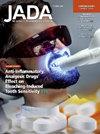在美国,一项人口普查匹配的牙科恐惧和恐惧治疗兴趣的调查
IF 3.5
2区 医学
Q1 DENTISTRY, ORAL SURGERY & MEDICINE
引用次数: 0
摘要
作者旨在通过第一次全国人口普查匹配的美国成人样本来测量牙科恐惧的流行程度,并在恐惧的人群中,对基于证据的数字恐惧治疗(即计算机化,移动应用程序和远程医疗方法)的兴趣或下降的原因。方法在2024年10月31日至11月11日期间进行了一项与人口普查相匹配的横断面在线调查(n = 1003),以确保美国成年人人口统计学特征的代表性。牙科恐惧采用经验证的Gatchel单条目量表(从0[无恐惧]到10[极度恐惧])进行评估。中度至重度恐惧的人被问及对数字治疗的兴趣,如果他们拒绝,则询问他们拒绝的原因。结果患病率为72.6% (95% CI为70.9% ~ 74.3%),其中45.8%报告中度恐惧,26.8%报告重度恐惧。在恐惧的人群中,71.2% (95% CI, 69.4%至73.0%)对数字化治疗感兴趣。那些拒绝的人表示对有效性持怀疑态度(31.8%),对他们的应对策略满意(23.4%),以及时间问题(22.3%)。结论:心理恐惧在美国仍然普遍存在,表明在降低患病率方面进展甚微。对数字治疗的高度关注表明对可获得干预措施的需求。实际意义简短的数字化牙科恐惧治疗提供了广泛传播的潜力。公共卫生信息必须解决那些对治疗有效性和价值不感兴趣的恐惧患者(≈30%)的怀疑态度。本文章由计算机程序翻译,如有差异,请以英文原文为准。
A census-matched survey of dental fear and fear-treatment interest in the United States
Background
The authors aimed to measure dental fear prevalence via the first national census-matched US adult sample and, among fearful people, interest in evidence-based digital fear treatment (ie, computerized, mobile application, and telehealth approaches) or reasons for declining.
Methods
A cross-sectional census-matched online survey (n = 1,003) was conducted (October 31-November 11, 2024) ensuring representation of US adult demographic characteristics. Dental fear was assessed using the validated Gatchel single-item scale (from 0 [no fear] through 10 [extreme fear]). People with moderate through severe fear were asked about their interest in digital treatment and, if they refused, about their reasons for declining.
Results
The prevalence was 72.6% (95% CI, 70.9% to 74.3%), with 45.8% reporting moderate fear and 26.8% reporting severe fear. Among fearful people, 71.2% (95% CI, 69.4% to 73.0%) were interested in digital treatment. Those who declined indicated skepticism about effectiveness (31.8%), satisfaction with their coping strategies (23.4%), and time concerns (22.3%).
Conclusions
Dental fear remains widespread in the United States, suggesting little progress in prevalence reduction. The high interest in digital treatment indicates demand for accessible interventions.
Practical Implications
Brief digital dental fear treatments offer potential for widespread dissemination. Public health messaging must address skepticism about treatment effectiveness and value among the fearful patients not yet interested (≈ 30%).
求助全文
通过发布文献求助,成功后即可免费获取论文全文。
去求助
来源期刊

Journal of the American Dental Association
医学-牙科与口腔外科
CiteScore
5.30
自引率
10.30%
发文量
221
审稿时长
34 days
期刊介绍:
There is not a single source or solution to help dentists in their quest for lifelong learning, improving dental practice, and dental well-being. JADA+, along with The Journal of the American Dental Association, is striving to do just that, bringing together practical content covering dentistry topics and procedures to help dentists—both general dentists and specialists—provide better patient care and improve oral health and well-being. This is a work in progress; as we add more content, covering more topics of interest, it will continue to expand, becoming an ever-more essential source of oral health knowledge.
 求助内容:
求助内容: 应助结果提醒方式:
应助结果提醒方式:


